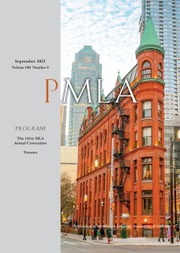Article contents
The Poverty of Context: Historicism and Nonmimetic Fiction
Published online by Cambridge University Press: 23 October 2020
Abstract
When scholars heed the “historicist turn” in literary criticism, invariably they try to situate a work in its relevant context. Doing so seems to confirm the work's social significance and its relation to proximate historical events. But what happens when a work dissolves these implied connections, rendering them provisional or meaningless? Is it evading context or pointing intelligently to that phenomenon's limited powers of determinism? This essay reconsiders whether contexts help or hinder understanding of especially antirealist fiction. What escapes context, I argue, alternately transfigures and defamiliarizes experience, thereby complicating our relation to the past.
Information
- Type
- Special Topic: Imagining History
- Information
- Copyright
- Copyright © Modern Language Association of America, 2003
References
Works Cited
- 31
- Cited by

